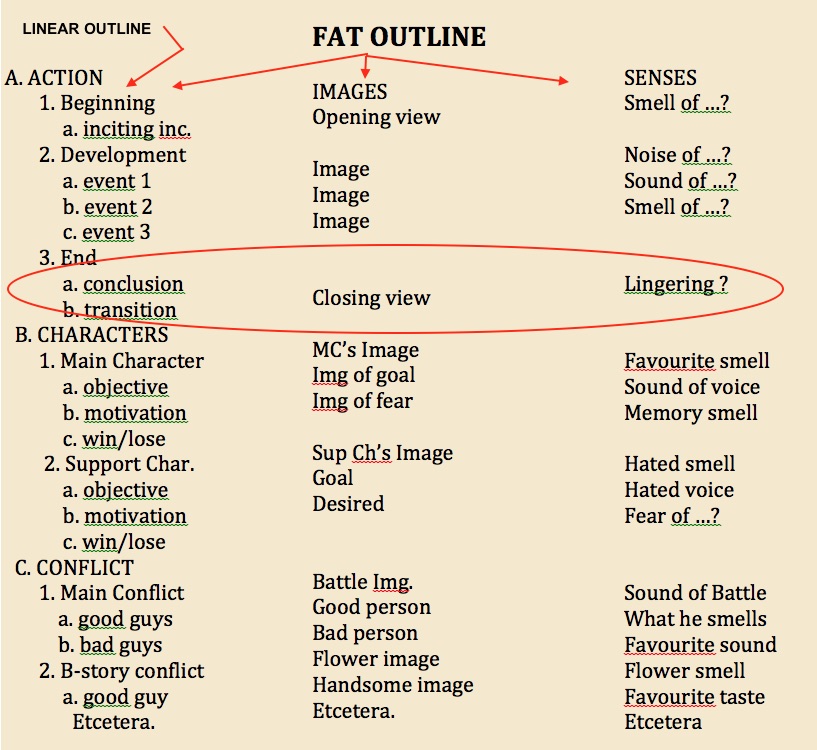
Okay, everybody knows about outlines. I used the letters-and-numbers version above. Bureaucracies, of course, like the specificity of decimals, “Please refer to section 1.1.4.5.” MSWord will automatically format these for you, if it doesn’t drive you nuts in the process by refusing to do it any other way.
I also freely admit that I never start my writing with an outline. But like Dean Lappi in his IU article, To Outline or Not to Outline, I always reach a stage in my project when I start an outline, because it’s impossible to keep it all straight in my head. My outlines in the past have been linear, like the left-hand column above.
We’re Always Improving
However, I have just learned about another kind of outline that has the potential to change my writing style for the better, so I’m sharing it with you. It’s called the Fat Outline.
Now, I’m not giving you the whole set of lessons in this article, just the main ideas. Sort of like an outline, you know?
I heard about this from Kat Lind in the 20booksto50k Facebook group, but the actual report comes from Solitaire Interglobal, a creator of high-end educational material.
The Standard Fat Outline
You can fatten your outline up with anything you like. I find it useful to put in main plot points, the characters in the scene, the climax, the conflict and who is winning, sometimes the whereabouts of characters not in the scene.
Cue Cards
Don’t get this new method mixed up with what a lot of people call a fat outline, which is no different from the cue card method many people use. Cue cards likewise allow you to put a number of concepts from each chapter, with the advantage that you can move the cue cards around.
Storyboard
If you’re even more visually oriented, you can pin those cue cards up on a wall like film directors do, so you have a picture of the story in front of you all the time.
What’s In the Chapter?
But all these details can fit on a linear outline, because they are all revealed in words. The great step forward in the Fat Outlines suggested by the Solitaire Interglobal guru is what else is on the cue card.
 The point here is that writers have three ways to reach their readers: words, images and senses. We all know that we should use them. What I didn’t realize was how much more powerful images and senses are than words, and how little I was taking advantage of this fact. This article has data from comprehensive studies that gives a very depressing take on effectiveness of the careful use of words. Like about 5% of the appeal. This author suggests that an image every thousand words would be effective. Think of it as 60 to 80 strong images in your story! And then there’s “Senses” on top of that.
The point here is that writers have three ways to reach their readers: words, images and senses. We all know that we should use them. What I didn’t realize was how much more powerful images and senses are than words, and how little I was taking advantage of this fact. This article has data from comprehensive studies that gives a very depressing take on effectiveness of the careful use of words. Like about 5% of the appeal. This author suggests that an image every thousand words would be effective. Think of it as 60 to 80 strong images in your story! And then there’s “Senses” on top of that.
When I outline my stories, what do I outline? The plot. The actions. Where characters are at given times. That’s what I have put on my chapter outlines in the past. This allows me to keep my plot flowing smoothly, to build my conflict to emotional peaks, and to keep each character’s personality development realistic and on track
But those essential elements of the story are all given to the reader in words. Did anybody ever think of putting the images and senses in their outlines? Not me, anyway. As a result, I write well-organized stories with sympathetic, complex characters, but not enough emotional impact.
Outlining Can Solve This
Our old-fashioned, linear outline can’t fill the bill. We have to find a way to add to that outline, so that every chapter also has an image or series of images, and likewise a series of senses. The Solitaire Interglobal article uses a spreadsheet, complete with colour coding. It requires a whole set of lessons to learn even the basics. If you’re the organized sort of “planster,” that will work great.
For us “pansters,” perhaps something simpler will do. In my experience, any system I make up myself, for all its flaws, is the one best suited for me. Plus I ease into it gradually, so I polish as I learn. I suggest you use the ideas of this post to make up your own template. Note that we haven’t even talked about adding “Emotions” to this version. The possibilities are endless.
Transitions
I circled one section of this outline because it reveals a key advantage of images and senses: latency. A sentence stays in our minds for a few seconds as we read. A visual or sensual image, besides being much more powerful, resides in a different part of our brain, so it will linger for much longer as we read on. This makes ending on a visual and sensory peak a wonderful way to keep the emotion flowing to the next chapter.
Getting Even Better
No longer will we have the hodge-podge, put-it-in-where-it-happens-to-fit, approach to images and senses. We will increase the use of these powerful tools, and our writing will increase in power.
Because the next step after that is not merely to use these elements constantly, but to have an emotional build in them to match the emotional build in the story. There is no sense putting in an effective image if it distracts readers from the rest of the tale. We want these elements to merge with the emotions already presented by the plot, conflict and characters until our story builds into a unified emotional experience that will really knock the readers’ socks off.
All because we outlined properly.

I like the idea of having a method for making sure I include the senses, and emotions or thoughts of the characters. It’s a weakness of mine, or so I’m told.
I’m not one to outline, but I do agree that using the senses is essential, and most of us don’t use smell enough. It’s a very powerful descriptor and mood-producer. Thanks, Gordon.
They tell us that smell is one of the most evocative senses to stimulate memory. This leads me to assume that it is powerful in the imagination in other ways. The difficulty is that it’s hard to describe a powerful smell in a few words.
Perhaps it’s a matter of setting up certain smells as factors in the story and repeating them to trigger the emotion set up the first time without having to go through the description all over again.
That’s really interesting. Thank you, Gordon. I don’t like to work with a very tight outline, but something like this could help me get various touchstones in.
This: ‘I start an outline, because it’s impossible to keep it all straight in my head.’ Yes.
I use dedicated writing software instead of Word, so outlining on the fly is a lot easier, but like you, I don’t do a ‘real’ outline until my head is ready to burst. And once a single book becomes a series…-facepalm-
Thank you for the Fat outline. It might just work for me who hates outlines.
I think a lot of people dislike outlines because of linear thinking. They assume that you’re supposed to write the outline first and then follow it. My brain certainly doesn’t work like that. I come up with ideas as I’m writing, so I couldn’t follow an outline that didn’t include the new stuff. Outlining is a “middle of the project” exercise for me.
Thanks for this fresh angle for outlining – enjoyed this post.
Great. Yet another convert! (Rubs hands together in glee).